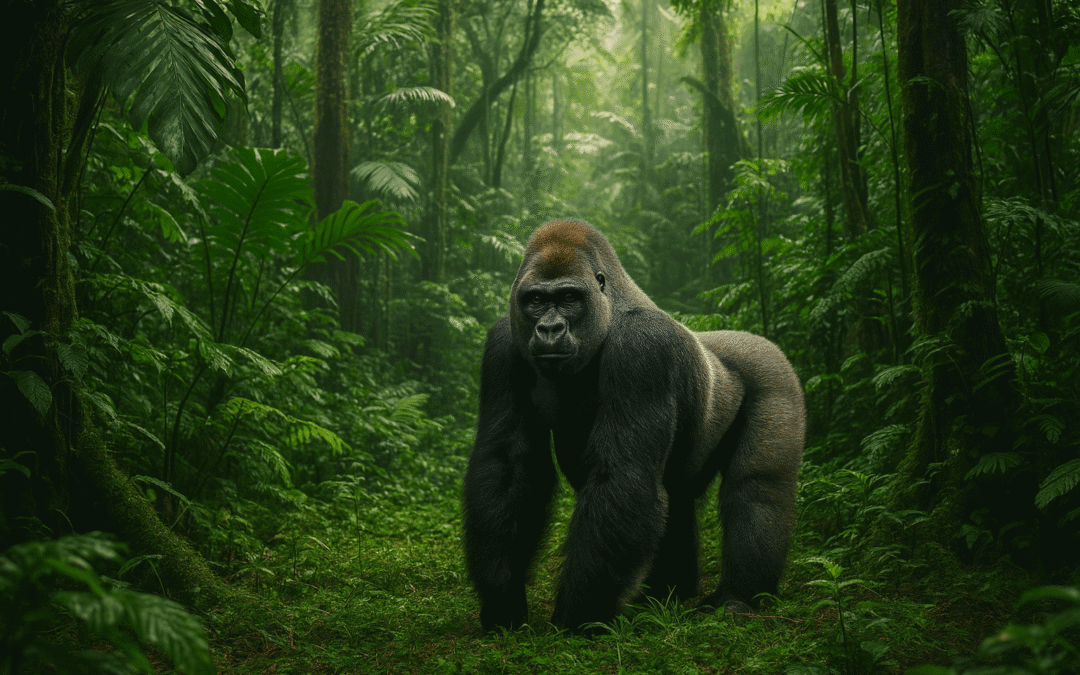In March 2016, I found myself in the kind of place most maps barely bother to name—an island within a jungle, within a park, within a little-known corner of Cameroon. I had joined three friends—Thomas, John, and Roberto—for an offbeat expedition to a remote area of Campo Ma’an National Park known as Dipikar Island.
Our goal? To witness something extraordinary: wild West African Lowland Gorillas being slowly habituated to humans.
We began in the coastal town of Limbe, where we set off at dawn in a rumbling 1985 Toyota Corolla 4WD station wagon driven by our local guide, Ben. The first day took us through the sticky sprawl of Douala, Cameroon’s commercial heartbeat, and then the seaside calm of Kribi, where we paused at a cascading waterfall. By dusk, we had reached Campo, a raw, dusty village situated just outside the boundaries of the national park, near its westernmost edge. The village lies along a main river that separates Cameroon from Equatorial Guinea. Here, a small population of native pygmies live under a fragile agreement with the government: protect the land, and they will be protected in return.
Campo had one potholed street, a scattering of wooden shops, and—unexpectedly—a lively bar ringed with plastic chairs and shaded by a tin roof. We settled into a barebones hostel, rinsed off the road dust, and shared cold beers and omelets under the humid night sky with Ben and Simeon, our local contact. It was a simple joy before plunging into the unknown.
The next morning, we were stirred awake by the shrill hum of cigar insects, louder than any alarm clock. After a quick supply run, we set out again—this time, headed for Dipikar Island, a dense, river-bound tract of jungle that seemed untouched by time. As we passed the faded sign for Parc National de Campo-Ma’an, the road gave way to a single-lane dirt path snaking through thick green. We followed a park ranger named Wilfred, who rode ahead on a motorcycle, camouflaged nearly to invisibility in his green uniform. Slung across his back was a collapsible .76 caliber rifle—an uneasy reminder that we were entering wild territory.
As we drove deeper, the light began to disappear—not because the sun had set, but because the jungle swallowed it. Trees wove thick canopies overhead, casting the path into a dusk-like dimness. At a final wooden bridge, we locked the car and crossed on foot. That’s when we met the Elephant Tree.
It rose from the forest floor like a guardian of centuries, a 200-year-old baobab tree with massive, buttressed roots that seemed to walk on their own. Tribal carvings marked its surface—herringbone patterns, geometric designs, and a massive elephant painted directly onto one of its roots by a local artist named Moise Mimb Billong. I tilted my head to find the top of the tree but couldn’t see it. It simply vanished into the canopy, ancient and unknowable.
Beyond the Elephant Tree, a sign leaned against a nearby baobab: Attention!! Zone Contrôlée par Les Caméras Pieges—a warning that motion-sensor cameras watched from the trees. We walked the remaining 4.3 kilometers into the heart of the jungle, packs on our backs, sweat dripping from our temples. The heat was thick and punishing, the air heavy with moisture and unseen life.
At last, we reached a small clearing that served as a temporary field station—a makeshift camp for researchers, gorilla trackers, forest workers, and conservationists. Tarpaulins stretched over wooden poles offered some shelter, while blue and black containers lined up beside cooking pots and metal pans. Clothes fluttered on a line strung between trees. A woman and man rested quietly in the shade, taking a break from work. This wasn’t just a camp. It was the beating heart of Project Gorilla Humanisation.
From 2011 to 2017, the World Wide Fund for Nature had funded this ambitious experiment: to habituate the gorillas on Dipikar Island—32 of them in total, forming two family groups—to tolerate human presence. The aim wasn’t just scientific. It was strategic and hopeful. If the gorillas could learn to trust, the area could one day host gorilla-watching tourism, bringing income to local communities and reducing the threat of poaching. But none of this would be possible without the slow, quiet labor of trust.
And trust, I would learn, cannot be forced. It must be earned—one breath, one presence, one patient return at a time.
That night, the jungle came alive. Hornbills with extravagant casques flitted across the canopy. Colobus monkeys chattered from the trees, though they never revealed themselves. The insect called “the Cigar”—a large cousin of the cicada—shrilled endlessly like an avian alarm.
At dawn, the trackers rose before us. By 9 a.m., news crackled through the short-wave radio: the gorillas had been spotted—just three kilometers from camp, toward the Equatorial Guinea border. We began our approach with anticipation humming through our bodies.
The plan was simple. Two or three trackers went first to reduce noise. Then we followed. We hiked through thick underbrush, then split into small groups to approach more quietly. And suddenly—it began.
From the thickets came a sudden chorus of guttural grunts and sharp hoots, followed by high-pitched screeches that pierced through the dense air. The jungle pulsed with movement. Branches shook. Leaves flew. Shapes darted through the green. The trackers beat their chests and slapped the ground—signaling territorial challenge, mimicking what dominant males do. “The ground slap,” one tracker explained, “means ‘I make a house here.’” The alpha males did not like that.
The forest exploded in sound and tension. We didn’t see all of them clearly, but we knew they were close. Six individuals—two families, including a giant alpha male and his son. The gorillas were always hiding. When we approached, they screamed and rushed from cover—but never fully revealed themselves. It felt like a dangerous game of peekaboo. Terrifying. Thrilling. And unforgettable.
We weren’t there to conquer the wild. We were there to witness the possibility that even something wild could one day learn to trust.
Later, back at camp, I sat under the tarp shelter, watching smoke curl up from the fire pit, and thought about the quiet miracle unfolding here. For years, these gorillas had been conditioned to run, to charge, to fear. And yet, simply by being present—by returning daily without harm—humans had slowly reshaped that fear. By 2018, 60% of the gorillas’ reactions to humans were neutral or even curious. Behavior, even deep-rooted instinct, could evolve.
That was the lesson I didn’t know I needed.
If a wild animal—primed by nature and evolution to avoid us—could slowly open to the unfamiliar, what did that say about me? About us?
How many paths do we never take simply because they feel foreign? How many parts of ourselves stay hidden, snarling and defensive, simply because no one has stayed long enough to build trust?
What Dipikar showed me is this: when we step into the unknown, the wild, or even the scary—not with force, but with presence—we begin to change. And so does the unknown.
Not every new path will lead somewhere. But if something pulls at you, intrigues you, won’t let you go—maybe the first step is simply to keep showing up. Let it see you. Let yourself be seen. And in time, what once screamed and ran might stay still long enough for you to glimpse something extraordinary.
That’s what I learned in the middle of nowhere.





What a beautiful story!
Thank you, Zan ❤️
I am fascinated by this story. I feel I was vividly experiencing the author’s personal narrative of her exploration in the jungle—it’s breathtaking!!!
Hi Susan, thank you so much for your kind words! That moment was truly unforgettable for me, and it means a lot to know it came through so vividly for you.
Very nice. Is it still possible to visit this area nowadays?
Hi Danay, the habituation project was supposed to end the following year that we were there in 2017. I’m not sure if they are open to visitors now which was really the intent of the project, to offer gorilla tours like ones in Rwanda. That would be worthwhile checking.
It’s normally hard for me to get focused on reading books or stories unless it’s really something about self improvement or advancement. Thanks for sharing your reflections on “Trust” in correlation with your travels.
Hi Amalie, I’m really glad the reflection on trust resonated with you. That means a lot, especially coming from someone who’s selective about what they read!